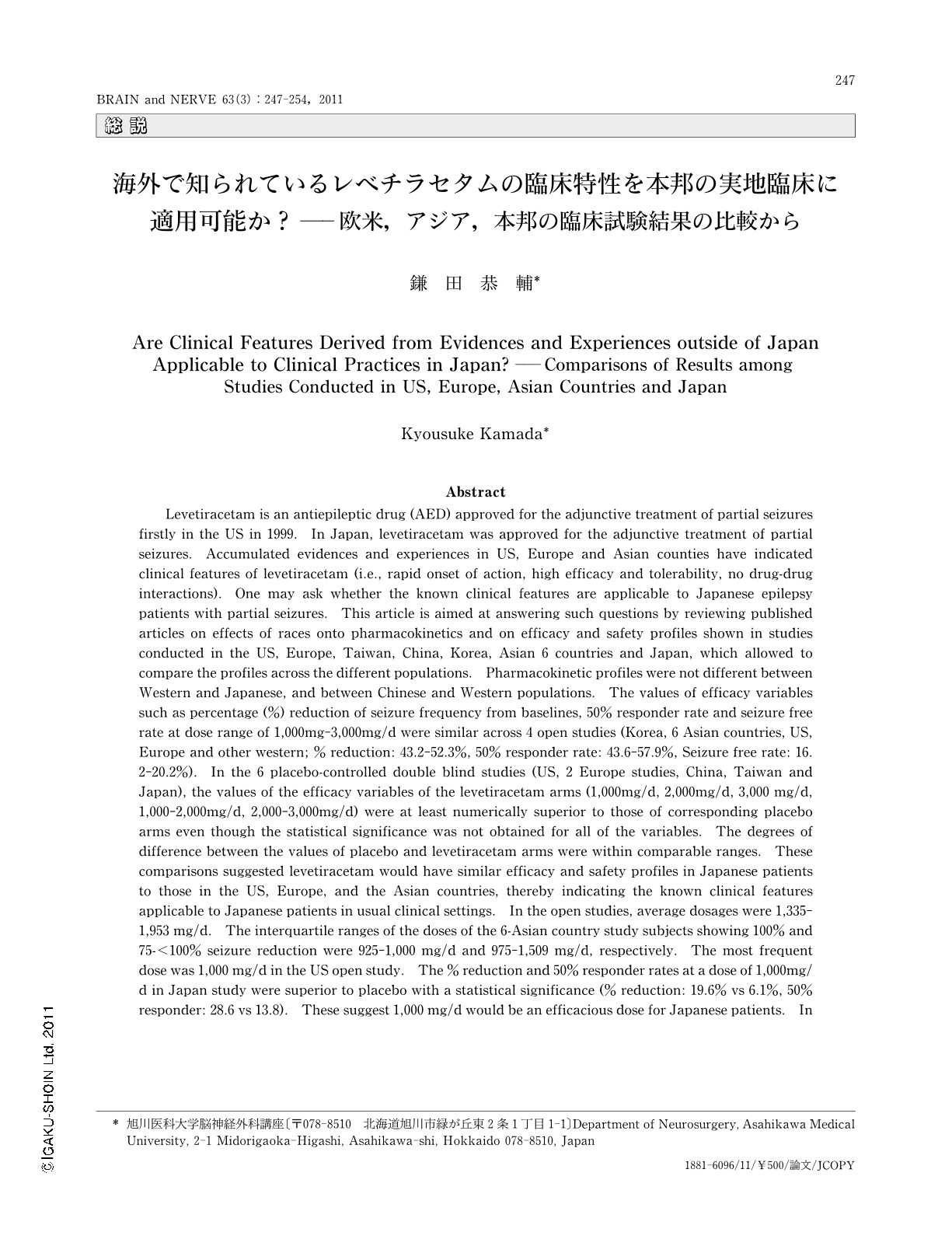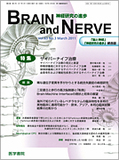Japanese
English
- 有料閲覧
- Abstract 文献概要
- 1ページ目 Look Inside
- 参考文献 Reference
はじめに
レベチラセタム(levetiracetam)は,米国で1999年に初めて,部分発作を有する成人てんかん患者に対する併用療法に用いる抗てんかん薬として承認され,その後,欧米や韓国,中国などで承認・発売されている。諸外国では,部分発作に対する併用療法および単剤療法,特発性全般てんかんの強直間代発作,若年ミオクロニーてんかんのミオクロニー発作に対する併用療法で承認され日常臨床に供されている。本邦では2010年9月に,成人の部分発作に対する併用療法の適応で発売された。
レベチラセタムの部分発作の併用療法における有効性・安全性について欧米を中心に数多くの臨床試験が実施され,さまざまな解析が行われている。薬物相互作用がほとんどないという特徴に加え,それらの解析結果から,例えば有効用量(1,000mg/日)から投与開始が可能で48時間で血漿中濃度が定常状態に達すること,投与開始翌日から発作抑制効果が発揮されること,有効性が十分高いことはもとより長期の忍容性に優れていること,長期投与による効果減弱がみられないことなどが報告されている1,2)。おそらく,これらの特徴が臨床現場で経験されたことから,米国のExpert Opinion3)でレベチラセタムが部分発作の併用療法で最も推奨される抗てんかん薬と位置づけられていると思われる。
抗てんかん薬の投与にあたって,開始から有効用量に至るまでの漸増期間の長さ,薬物相互作用や長期投与による効果減弱などの問題に苦慮している本邦の実地医家にとって,このような特徴を持つレベチラセタムが実際に使用可能になることへの期待は当然と思われる。しかしながら,欧米での臨床試験の結果や実際の使用経験をそのまま日本人の患者に適用可能であるか否かという点についてはいまだ十分には論じられていない。
欧米の臨床試験結果をもとに導かれているレベチラセタムの臨床的特徴のうち,本邦の臨床現場に適用しがたい点が仮にあるとするなら,それはいかなる点なのであろうか。こういった事柄はレベチラセタムをこれから処方する本邦の医師にとっては関心のあるところであろうし,レベチラセタムが本邦の臨床に供された際の重要な情報と思われる。
そこで本稿では,レベチラセタムの薬物動態について,欧米人と日本人あるいは中国人の比較を行い,次いで,部分発作に対する併用療法の有効性・安全性を検討した臨床試験のうち,本邦および,遺伝的に日本人と近いと思われる中国,台湾,韓国それぞれで行われた4つの臨床試験と欧米で行われた臨床試験の結果を比較し,アジアと欧米での差異を論じる。そのうえで,本邦での臨床に適用可能あるいは適用困難なレベチラセタムの特徴について述べたい。
Abstract
Levetiracetam is an antiepileptic drug (AED) approved for the adjunctive treatment of partial seizures firstly in the US in 1999. In Japan, levetiracetam was approved for the adjunctive treatment of partial seizures. Accumulated evidences and experiences in US, Europe and Asian counties have indicated clinical features of levetiracetam (i.e., rapid onset of action, high efficacy and tolerability, no drug-drug interactions). One may ask whether the known clinical features are applicable to Japanese epilepsy patients with partial seizures. This article is aimed at answering such questions by reviewing published articles on effects of races onto pharmacokinetics and on efficacy and safety profiles shown in studies conducted in the US, Europe, Taiwan, China, Korea, Asian 6 countries and Japan, which allowed to compare the profiles across the different populations. Pharmacokinetic profiles were not different between Western and Japanese, and between Chinese and Western populations. The values of efficacy variables such as percentage (%) reduction of seizure frequency from baselines, 50% responder rate and seizure free rate at dose range of 1,000mg-3,000mg/d were similar across 4 open studies (Korea, 6 Asian countries, US, Europe and other western; % reduction: 43.2-52.3%, 50% responder rate: 43.6-57.9%, Seizure free rate: 16.2-20.2%). In the 6 placebo-controlled double blind studies (US, 2 Europe studies, China, Taiwan and Japan), the values of the efficacy variables of the levetiracetam arms (1,000mg/d, 2,000mg/d, 3,000 mg/d, 1,000-2,000mg/d, 2,000-3,000mg/d) were at least numerically superior to those of corresponding placebo arms even though the statistical significance was not obtained for all of the variables. The degrees of difference between the values of placebo and levetiracetam arms were within comparable ranges. These comparisons suggested levetiracetam would have similar efficacy and safety profiles in Japanese patients to those in the US, Europe, and the Asian countries, thereby indicating the known clinical features applicable to Japanese patients in usual clinical settings. In the open studies, average dosages were 1,335-1,953 mg/d. The interquartile ranges of the doses of the 6-Asian country study subjects showing 100% and 75-<100% seizure reduction were 925-1,000 mg/d and 975-1,509 mg/d, respectively. The most frequent dose was 1,000 mg/d in the US open study. The % reduction and 50% responder rates at a dose of 1,000mg/d in Japan study were superior to placebo with a statistical significance (% reduction: 19.6% vs 6.1%, 50% responder: 28.6 vs 13.8). These suggest 1,000 mg/d would be an efficacious dose for Japanese patients. In addition to the direct effects on seizures, these studies demonstrated that levetiracetam improved cognitive functions and quality of life of subjects.
(Received: July 15,2010,Accepted: November 1,2010)

Copyright © 2011, Igaku-Shoin Ltd. All rights reserved.


